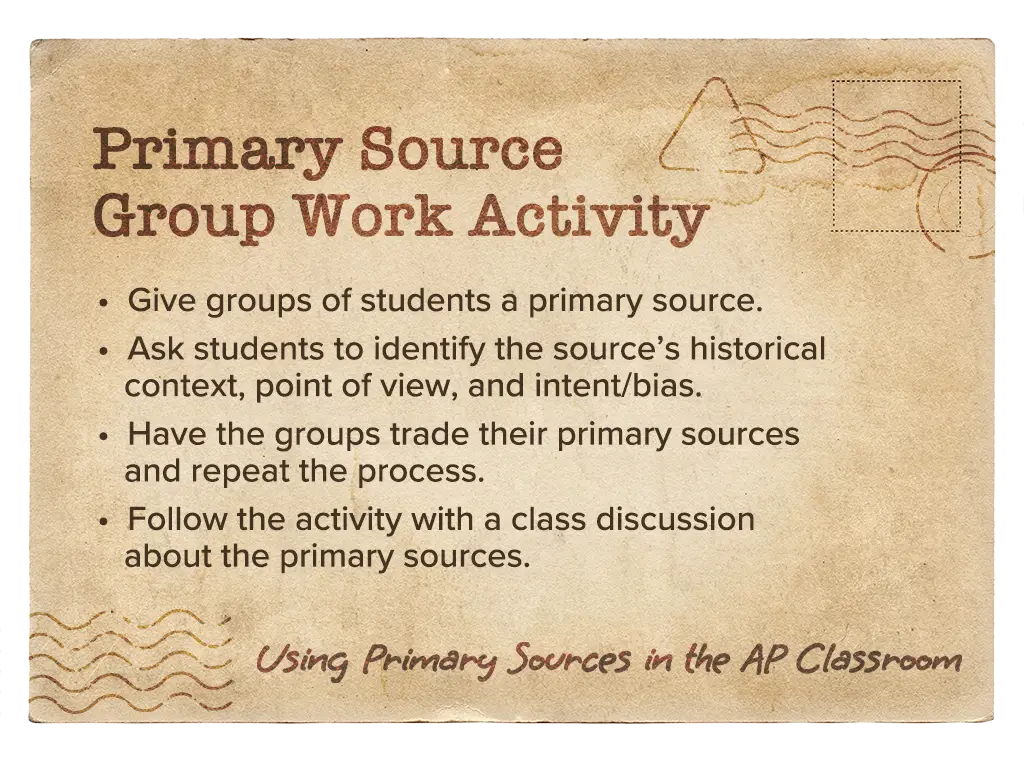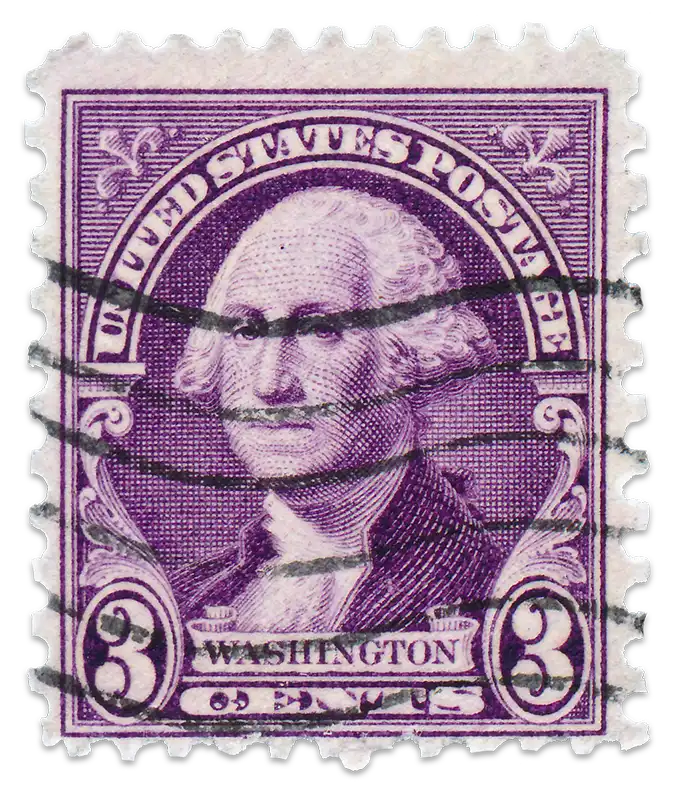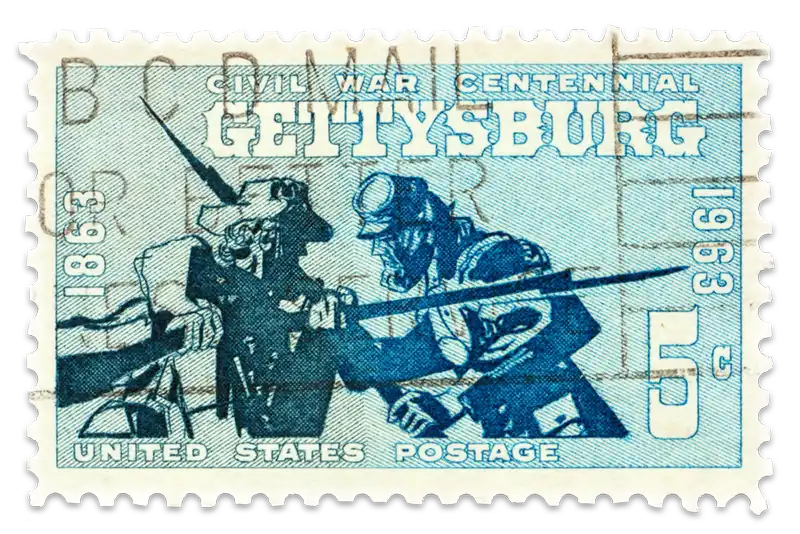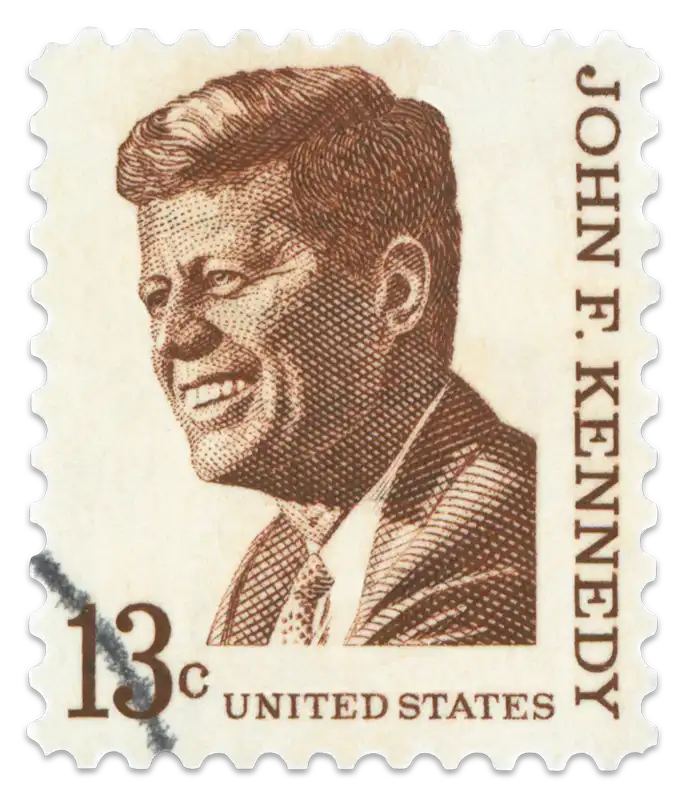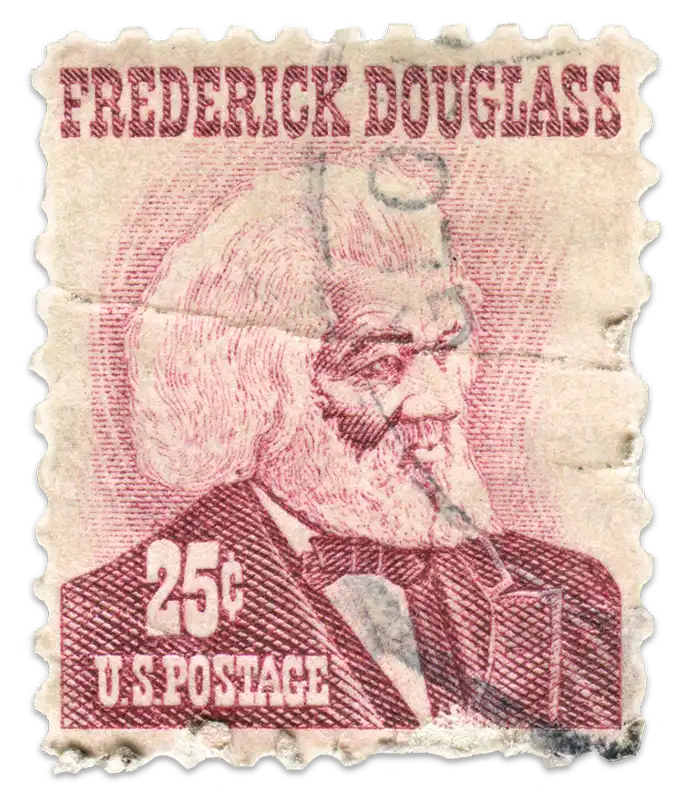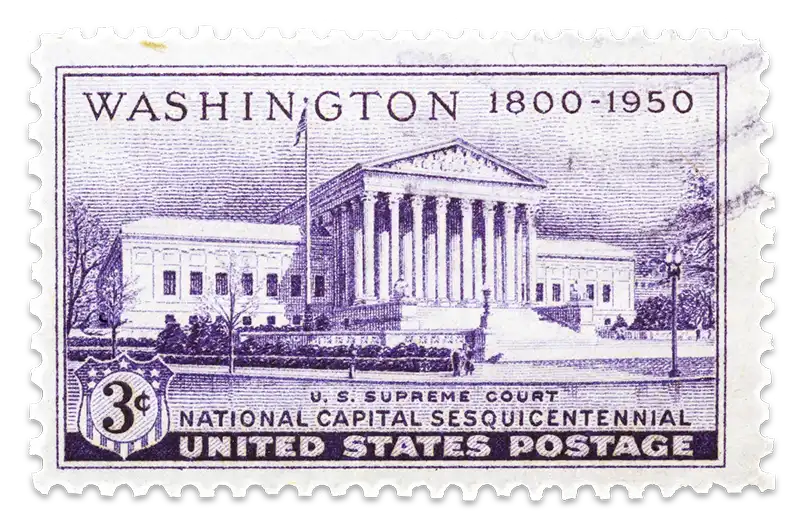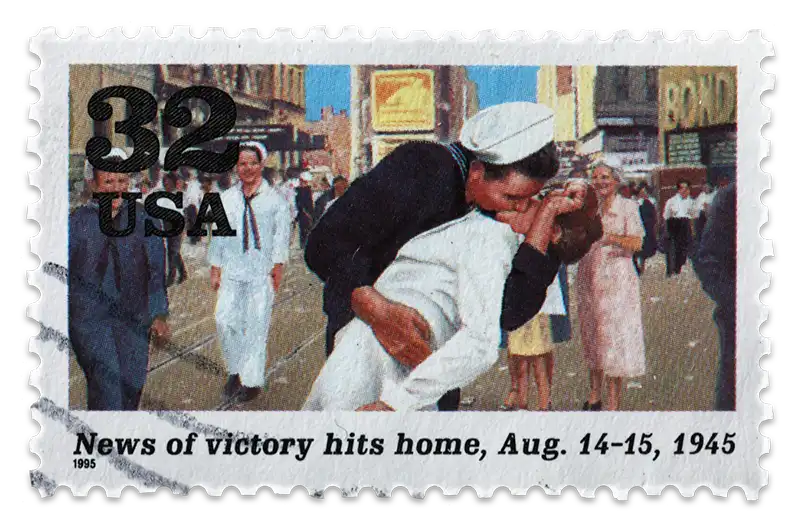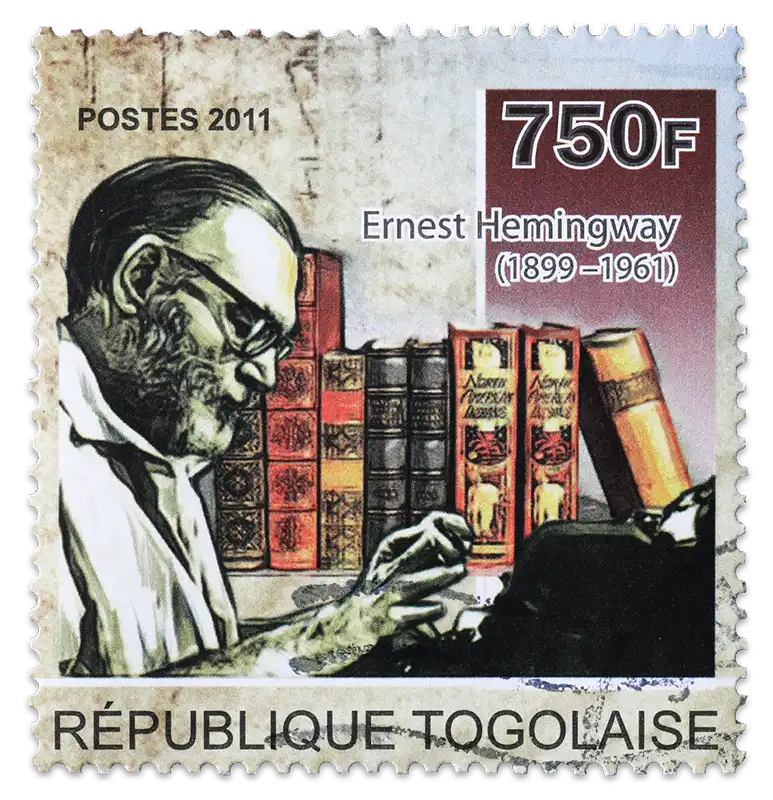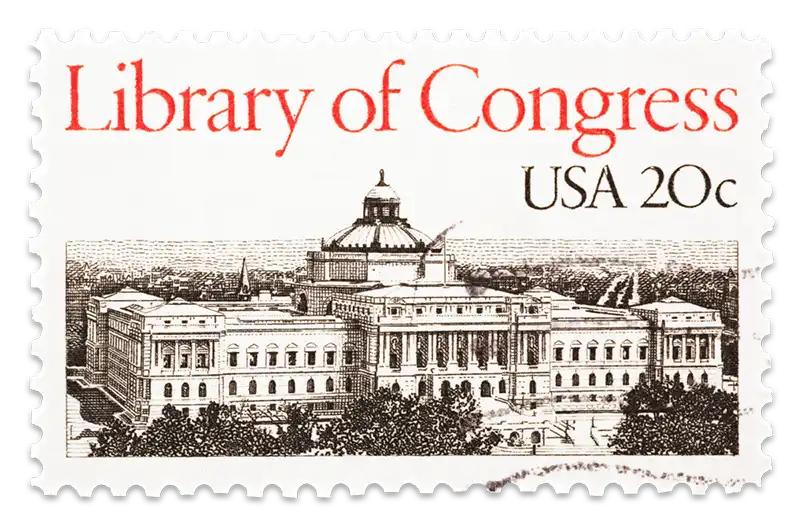AP® U.S. History Primary Sources
If you were ever a small child [as most of us once were], you are most likely familiar with a game called Telephone. For those who have never played it, the game begins with one participant whispering something into another person’s ear, making sure that none of the other participants playing the game can hear what they’ve said. The recipient of this whispered message then shares what they believe they’ve heard in another person’s ear, and then that participant passes the message along to another person, and so forth. The last participant to hear the message then announces what they think it was to the group. It inevitably differs from the original message that the person who whispered it first shared.
In a way, history kind of works like this, too. Over the years, the original context and understanding of a historical event or time period can become skewed as each person interprets it differently, projecting their own biases and opinions, before passing that information along to future generations through secondary sources. The whole process can make it difficult to truly understand how a historical event really happened.
One of the best ways to avoid this while learning AP® United States History is to study primary sources. Although firsthand accounts of historical events and time periods come with their own biases, they also come from the point of view of people who were actually there and give students a greater understanding of the circumstances and various viewpoints of the people who experienced the actual event. Incorporating American history primary sources into an APUSH class is vital in order to help students truly understand course content and concepts.
Incorporating American History Primary Source Documents into Your APUSH Class
AP U.S. History primary sources, such as letters, diaries, photographs, speeches, and government documents, provide a closer look into historical events and give students a deeper understanding of the past. APUSH teachers can use primary sources in many ways, such as with group work, research projects, and class discussions.
For instance, a teacher might assign each group or partner in the class a primary source document to analyze. They can talk about the language used, the historical context, the biases present, etc. Or a teacher might assign their class a bell ringer that entails discussing and debating AP U.S. History primary sources connected to the day's lesson. As an exit ticket at the end of class, students could also write a reflection about a primary source pertinent to their lesson.
American history primary sources can be used to teach students analytical and critical thinking techniques, empowering them to think creatively and apply their knowledge when drawing conclusions about the past.
APUSH Government Documents
In AP United States History, significant American documents are essential to understanding the nation's past and its continuing evolution. These documents provide a window into the political, social, and economic forces that have shaped American society, and they help us understand how the United States has become the country it is today.
Some of the most significant American documents include the Declaration of Independence, the U.S. Constitution, and the Bill of Rights.1 These AP U.S. history primary sources are not only important in their own right, but they also provide a framework for understanding contextually-related historical events. Additionally, understanding the impact of these documents can help students better interpret current events and the ongoing political and social debates in the United States.
The Declaration of Independence is a historic document that declared the United States to be a new and independent nation, separate from British rule. It outlined the fundamental ideas of democracy, equality, and natural rights, which have since dominated American politics and society.
The United States Constitution (1787)
The United States Constitution is a foundational document that outlines the framework for the country's government and laws. It establishes the three branches of government, protects individual rights, and has been used as a template for democratic government all over the world.
Bill of Rights (1791)
The Bill of Rights is a collection of ten amendments to the United States Constitution that were added in 1791 to protect individual liberties and limit the power of the federal government. It guarantees rights such as freedom of speech, religion, protection of the press, and the right to a fair trial, among others.

Homestead Act (1862)
In 1862, Congress passed a law known as the Homestead Act that provided land to settlers in the western United States. To encourage migration and settlement westward, it offered 160 acres of public land to anyone who would farm the land for at least five years.
The Emancipation Proclamation (1863)
President Abraham Lincoln issued the Emancipation Proclamation during the Civil War in 1863, announcing the freedom of all enslaved people in the United States. Even though it did not immediately free all people who were enslaved at the time, it was a significant turning point in the struggle against slavery and paved the way for its eventual abolition in the United States.
The 14th Amendment (1868)
The 14th Amendment to the United States Constitution was adopted in 1868. It grants citizenship to anyone born or naturalized in the U.S. and guarantees the same legal protection and due process of law to all people. This amendment has been cited in a number of significant court cases and has contributed to the advancement of civil rights for all Americans.
The 19th Amendment (1920)
In 1920, the 19th Amendment was adopted, recognizing women's equality in political participation and granting them the right to vote. This was a significant turning point in the struggle for gender equality and opened the door for more women in the United States to participate in politics.
Civil Rights Act of 1964 (1964)
With the passage of the Civil Rights Act of 1964, discrimination on the basis of race, color, religion, sex, or nationality was outlawed in many parts of American society, including the workplace, the classroom, and public places. It was a major victory for the Civil Rights Movement and paved the way for greater equality and justice in the United States.
AP U.S. History Speeches
American speeches have had a significant impact on the political and cultural landscape of the United States. Speeches have been used since the founding of the country to express important ideas, lead people, and inspire change. From Abraham Lincoln's “Gettysburg Address” to Martin Luther King Jr.'s "I Have a Dream," these iconic speeches have become a part of American culture and have helped shape the course of history.2
Important American speeches are noteworthy not only for their historical importance but also as examples of how language can sway public opinion and advance social and political change.
“Give Me Liberty or Give Me Death!” by Patrick Henry (1775)
American patriot Patrick Henry urged the Virginia Convention to fight for independence in his speech "Give Me Liberty or Give Me Death!" on March 23, 1775. The speech was a powerful call to action that built up support for the American Revolution and helped inspire colonists to fight for their freedom.
“Farewell Address” by George Washington (1783)
George Washington's Farewell Address was a seminal speech delivered by the first President of the United States in 1796, in which he announced his retirement and offered his guidance to future generations. In the speech, Washington warned against political parties, urged national unity and the preservation of the Constitution, and emphasized the importance of foreign policy neutrality and non-interventionism.
“Ain’t I a Woman?” by Sojourner Truth (1851)
The 1851 "Ain't I a Woman?" speech by Sojourner Truth is a potent and well-known example of how race and gender intersect in America. Through her words, Truth challenges the notions of gender and race that were prevalent at the time, and calls for equality and justice for all people.
“What to the Slave is the Fourth of July?” by Frederick Douglass (1852)
In his 1852 speech, "What to the Slave is the Fourth of July?," Frederick Douglass criticized the hypocrisy of celebrating American independence while millions of African Americans continued to be held in slavery. In his speech, Frederick Douglass condemns the practice of slavery and encourages Americans to uphold the principles of justice and freedom set forth in the Declaration of Independence.
The “Gettysburg Address” by Abraham Lincoln (1863
Abraham Lincoln's "Gettysburg Address," delivered in 1863, is one of the most famous and iconic speeches in American history. In his speech, Lincoln reflects on the sacrifices of those who died in the Civil War and affirms the importance of preserving the Union and upholding the principles of democracy and freedom.
“Seneca Falls Convention” by Elizabeth Cady Stanton (1848)
Elizabeth Cady Stanton’s speech at the Seneca Falls Convention in 1848 is considered a pivotal moment in the struggle for American women's suffrage.5 In her speech, Stanton advocates for women's rights and outlines a detailed plan for achieving gender equality.
“I Will Fight No More” by Chief Joseph (1877)
Following a protracted and challenging conflict with the United States government over ownership of their ancestral lands, Chief Joseph of the Nez Perce tribe made the speech "I Will Fight No More Forever" in 1877. The speech was a powerful and moving plea for peace, in which Chief Joseph expressed his desire to end the violence and suffering of his people.
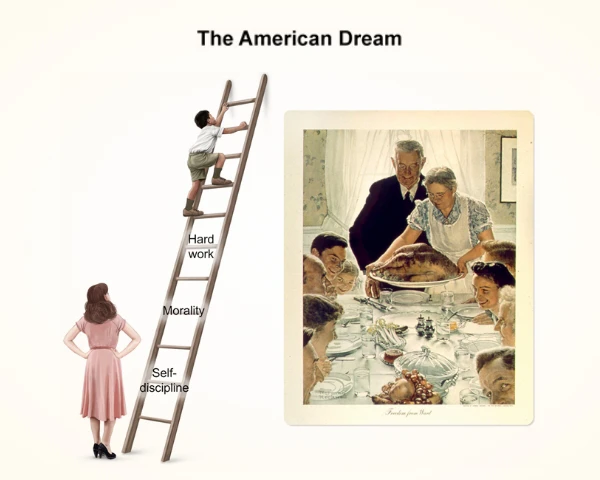
“Freedom or Death” by Emmeline Pankhurst (1913)
Emmeline Pankhurst called for militant action in the fight for equality in her 1913 speech "Freedom or Death," which supported women's suffrage. She implores women to take direct action and fight for their rights, even at the risk of imprisonment or death.
“Inaugural Speech” by Franklin D. Roosevelt (1933)
Franklin D. Roosevelt's inaugural speech, delivered on March 4, 1933, famously declared that "the only thing we have to fear is fear itself" and outlined his plans to address the economic and social challenges facing the United States during the Great Depression.
“Luckiest Man” by Lou Gehrig (1939)
On July 4, 1939, Lou Gehrig, a baseball player for the New York Yankees, delivered this speech after announcing his retirement from the game due to a diagnosis of amyotrophic lateral sclerosis (ALS), which would later become known as Lou Gehrig's disease. It was a heartfelt tribute to Gehrig's teammates, family, and fans, and has since become one of the most famous speeches in American sports history.
“Pearl Harbor Address” by Franklin D. Roosevelt (1941)
Franklin D. Roosevelt delivered the well-known "Pearl Harbor Address" in 1941, which announced America's entry into World War II. In his speech, Roosevelt talks about Japan's devastating surprise attack on Pearl Harbor and urges everyone to work together to stop the Axis powers and win the war for the Allies.
“Inaugural Address” by John F. Kennedy (1961)
John F. Kennedy's 1961 Inaugural Address emphasized the importance of civic duty, international cooperation, and national unity. One of its most famous lines, "Ask not what your country can do for you; ask what you can do for your country," has become an iconic phrase that encapsulates Kennedy's vision for Americans to be more engaged and responsible citizens.
“I Have a Dream” by Dr. Martin Luther King Jr. (1963)
One of the most well-known and recognizable speeches in American history is Dr. Martin Luther King Jr.'s "I Have a Dream" speech, which he gave during the 1963 March on Washington.6 King calls for an end to racial discrimination and segregation in his speech and imagines a time when all Americans will be assessed on the merits of their character rather than the color of their skin.
“Tear down this wall!” by Ronald Reagan (1987)
In his famous "Tear Down This Wall" speech in 1987, Ronald Reagan called for the fall of the Berlin Wall and the end of the Cold War at Berlin's Brandenburg Gate.7 In his speech, Reagan challenges Soviet leader Mikhail Gorbachev to embrace freedom and democracy, and famously declares, "Mr. Gorbachev, tear down this wall!"
APUSH Historical Documents, Personal Accounts, Letters, and Narratives
To truly understand American history, it’s important to examine the daily lives of people, their firsthand experiences, and the historical context in which they lived. Historical documents, personal accounts, letters, and narratives are great for this. These invaluable primary sources offer a real glimpse into pivotal moments in American history, giving us a clear picture of the thoughts and perspectives of those who experienced them.
The American Crisis, by Thomas Paine (1775)
Thomas Paine's "The American Crisis" is a collection of essays written during the American Revolution that played a crucial role in motivating American citizens to take their independence from England. Paine's passionate words and unwavering commitment to the cause helped build public support for the revolutionary movement and ultimately led to the defeat of the British army.
The Federalist Papers by Alexander Hamilton, James Madison, and John Jay (1787-1788)
The Federalist Papers are a collection of essays written by Alexander Hamilton, James Madison, and John Jay during the late 18th century that were instrumental in shaping the United States Constitution. These essays helped to shape the writing and ratification of the Constitution by offering important insights into the theoretical and practical foundations of the newly established federal government.

The Autobiography of Benjamin Franklin by Benjamin Franklin (1791)
The autobiography of Benjamin Franklin is one of the most famous and influential memoirs in American history. It offers a fascinating look at the life and accomplishments of one of America's most important founding fathers and illuminates Benjamin Franklin's numerous contributions to science, politics, and diplomacy.
Journals of the Lewis and Clark Expedition (1804-1806)
The journals from the Lewis and Clark expedition are some of the most important historical documents from the early years of the United States. They provide a detailed and vivid account of the first expedition to explore the western territories of the United States, and offer valuable insights into the landscape, wildlife, and indigenous peoples of the region.
Narrative of the Life of Frederick Douglass, an American Slave by Frederick Douglass (1845)
The Narrative of the Life of Frederick Douglass, an American Slave, is a powerfully written work that offers readers an unflinching look at the horrors of slavery. The narrative, which Douglass himself wrote, serves as both a personal account of his experiences as an enslaved person and a call to action for abolitionists.
Letters from a Birmingham Jail by Dr. Martin Luther King Jr. (1963)
Dr. Martin Luther King Jr.'s "Letters from a Birmingham Jail" are historically significant because they represent a powerful defense of nonviolent resistance and a call for civil rights for African Americans.8 Inspiring and challenging readers even today, the letters are a passionate and persuasive defense of the values of justice, equality, and human dignity.
AP U.S. History Newspaper and Magazine Sources
Newspapers and magazines have played a significant role in the history of the United States, acting as the backbone of free speech and reporting for the American press. Newspaper and magazine articles can provide a unique perspective on historical events, offering a glimpse into the social and cultural context of a specific time period.3 By taking a close look at the articles published in newspapers and magazines of a given era, people can gain insights into the attitudes, beliefs, and values of the time. Because of this, historians frequently use newspapers and magazines as primary sources in their work, which allows them to develop a more thorough understanding of the past.
“Ten Days in a Mad-House,” by Nellie Bly in the New York World newspaper (1887)
The news article "Ten Days in a Mad-House" by Nellie Bly is known for its groundbreaking investigative journalism that exposed the inhumane conditions of a mental institution in the late 19th century.9 Bly's undercover reporting not only helped to bring about much-needed reforms to the treatment of mental health patients but also inspired a new generation of female journalists to enter the field of investigative reporting.
"The Wounded Knee Massacre" by the New York Times (1890)
The New York Times article, "The Wounded Knee Massacre," documents one of the most notorious instances of violence against Native Americans in U.S. history.10 The article highlights the unjust and inhumane treatment that the Lakota Sioux people endured at the hands of the U.S. government and serves as a powerful reminder of the ongoing struggle for Native American rights and recognition.
"The Jungle" by Upton Sinclair in the socialist newspaper, Appeal to Reason (1905)
"The Jungle" by Upton Sinclair is a novel that exposed the unsanitary and dangerous working conditions in the meatpacking industry in Chicago in the early 1900s. It was published as a serialized story in the socialist newspaper "Appeal to Reason" before being published as a book in 1906.11 The book caused a public outcry and led to the passage of the Meat Inspection Act and the Pure Food and Drug Act, which aimed to regulate the food industry and protect consumers.
"The Watergate Scandal" by Carl Bernstein and Bob Woodward in The Washington Post (1972-1974)
It was the Washington Post's coverage of the Watergate scandal that helped expose Nixon's administration's wrongdoing and corruption, which ultimately forced his resignation.12 The reporters' investigative work demonstrated the importance of a free and independent press in holding those in power accountable.
AP U.S. History Court Records
Historical court cases have shaped the legal and political landscape of the United States. Many of these cases, which have had a significant impact on American society, involved concerns like civil rights, free speech, and due process. In the famous 1954 case Brown v. Board of Education4, for example, segregation in public schools was declared unconstitutional. This paved the way for the civil rights movement of the 1960s.
Court cases are not only important for their legal outcomes, but also for the debates and discussions they inspire. They often serve as a reflection of the broader social and political context in which they arise.
Marbury v. Madison (1803)
Marbury v. Madison was a landmark Supreme Court case that established the concept of judicial review, giving the Court the power to strike down unconstitutional laws passed by Congress. This decision helped clarify the balance of power between the executive, legislative, and judicial branches of the American government.
Dred Scott v. Sandford (1857)
The Dred Scott v. Sandford court case was significant in the lead-up to the Civil War as it declared that African Americans were not citizens and therefore had no right to sue in federal court. This decision fueled the abolitionist movement and contributed to the growing tensions between the North and the South.
Plessy v. Ferguson (1896)
The Plessy v. Ferguson court case established the "separate but equal" doctrine, which allowed racial segregation in public facilities as long as they were deemed equal in quality. The landmark Brown v. Board of Education case later overturned this decision.
Brown v. Board of Education (1954)
The Brown v. Board of Education court case declared segregation in public schools unconstitutional, overturning the Plessy v. Ferguson doctrine of "separate but equal." It sparked the Civil Rights Movement and inspired future legal challenges to segregation and discrimination practices in America.
Miranda v. Arizona (1966)
The Miranda v. Arizona court case established the rule that anyone detained by the police who has been placed under arrest must be made aware of their right to remain silent and the right to have an attorney present while being questioned. This decision ensured the protection of individual rights and has had a significant impact on criminal justice practices in the United States.
Roe v. Wade (1973)
Roe v. Wade established the constitutional right to access safe and legal abortion in the United States. The decision had a significant impact on reproductive rights and has continued to spark debate and controversy to this day.
AP U.S. History Photographs
American historical photographs are important because they enable us to view and experience historical events that we otherwise would not be able to witness. They convey the spirit of a situation, individual, or event and can shed light on the social, political, and cultural atmosphere of the time.
Photographs also have the power to evoke emotion and convey meaning beyond words. They can provide visual evidence to support arguments and theories, as well as contribute to the understanding of the context in which events happened. American historical photographs are an important and valuable part of our cultural heritage, offering a window into the past and a way to understand the present.
"Migrant Mother" by Dorothea Lange (1936)
The photograph "Migrant Mother" by Dorothea Lange is a significant image in American history as it has become an iconic representation of the Great Depression.13 The image shows a destitute mother and her children, showcasing the difficulties and struggles faced by many during this time, and has become a symbol of economic hardship during this tough time in history.
"Flag Raising on Iwo Jima" by Joe Rosenthal (1945)
The photograph "Flag Raising on Iwo Jima" is from World War II and captures the moment when U.S. Marines raised the American flag on top of Mount Suribachi during the Battle of Iwo Jima.14 The photograph became a symbol of American courage and is regarded as one of the most iconic images of the 20th century.
"Bloody Sunday" by Charles Moore (1965)
The Civil Rights Movement's turning point was captured in the picture "Bloody Sunday," which shows state troopers brutally attacking nonviolent protesters on the Edmund Pettus Bridge in Selma, Alabama. The photograph, which depicts police beating and gassing protesters, served to increase public support for the Voting Rights Act of 1965 and to highlight the violence and systemic racism that Black Americans in the South endured.15

"V-J Day in Times Square" by Alfred Eisenstaedt (1945)
The photograph "V-J Day in Times Square" is an iconic image that captured a spontaneous celebration on August 14, 1945, when news of Japan's surrender in World War II reached the United States. The image has come to represent the end of the war as well as the happiness and relief that Americans experienced at the time.
"Dust Bowl" by Arthur Rothstein (1936)
The photograph "Dust Bowl" by Arthur Rothstein captures the devastating effects of the Dust Bowl on the Great Plains during the 1930s, helping to raise awareness of the struggles farmers and their families experienced during the era. The image of a dust storm looming over a deserted farmstead is an iconic representation of the Dust Bowl.
AP U.S. History Artistic or Creative Works
American historical artistic and creative works are important cultural artifacts that provide insights into the social, political, and economic contexts of their time. They capture the values, beliefs, and emotions of the people who created them and offer a unique perspective on American history. American art and literature, in particular, have played an essential role in shaping the national identity and cultural heritage of the United States.
"The Star-Spangled Banner" by Francis Scott Key (1814)
The Star-Spangled Banner is a patriotic song and the national anthem of the United States. Francis Scott Key wrote it during the War of 1812, and it became a symbol of American patriotism.16 The song is played at public events and sports games, and its lyrics and melody have become ingrained in American culture.
Adventures of Huckleberry Finn by Mark Twain (1884)
Published in 1885, "The Adventures of Huckleberry Finn" by Mark Twain is considered one of the greatest American novels.17 The novel has been both celebrated and criticized for its portrayal of racial stereotypes and the use of racial slurs, but it remains a notable work in American literature as a reflection of its time.
The Great Gatsby by F. Scott Fitzgerald (1925)
"The Great Gatsby," written by F. Scott Fitzgerald, released in 1925, is regarded as one of the greatest American novels of the 20th century and a key piece of Jazz Age literature.18 The book explores themes of wealth, power, love, and the American Dream. Because of its vivid depiction of the excess and decadence of the Roaring Twenties, it has become a cultural touchstone and an enduring critique of the corruption and pointlessness of the pursuit of wealth and status.
“American Gothic” by Grand Wood (1930)
One of the most recognizable American works of art, "American Gothic" by Grant Wood, has come to represent the American Midwest. Different people have interpreted the painting's depiction of a stern, hardworking couple standing in front of a Gothic-style farmhouse in different ways. Some see it as a celebration of rural American life, while others see it as a commentary on the isolation and hardship that farmers experienced during the Great Depression.
"Strange Fruit" by Billie Holiday (1939)
The song "Strange Fruit" tackles the subject of racism and lynching in America in a strong and highly emotional way. It became a crucial anthem of the civil rights movement and contributed to increasing awareness of the crimes against Black Americans at the time.
“Rosie the Riveter” Poster by J. Howard Miller (1942)
Over the years, a number of artists and designers have claimed credit for the "Rosie the Riveter" image, but J. Howard Miller's 1942 "Rosie the Riveter" poster is the one most frequently associated with it. During World War II, this poster rose to fame as an iconic representation of the feminist movement in America and female emancipation. It illustrated the crucial contribution that women made to the war effort by taking on traditionally male-dominated jobs in factories and other sectors, and it served as inspiration for a generation of women to fight for equal rights and opportunities both at work and elsewhere.
“The Old Man and the Sea” by Ernest Hemingway (1952)
Ernest Hemingway's Pulitzer Prize-winning book "The Old Man and the Sea" is about an elderly Cuban fisherman's struggle to capture a massive marlin and his ultimate struggle to bring it back to land.19 The book is regarded as a classic of American literature and is noted for its themes of courage, resiliency, and the struggle for survival, as well as its tastefully sparse writing style.
"The Feminine Mystique” by Betty Friedan (1963)
"The Feminine Mystique" by Betty Friedan is a groundbreaking feminist book that challenged the traditional gender roles of women in the mid-twentieth century and helped to spark the second-wave feminist movement.20 The book called for more opportunities and equality for women in all facets of society as it explored the idea of "the problem that has no name," or the unhappiness and lack of fulfillment that many women experienced in their domestic lives.
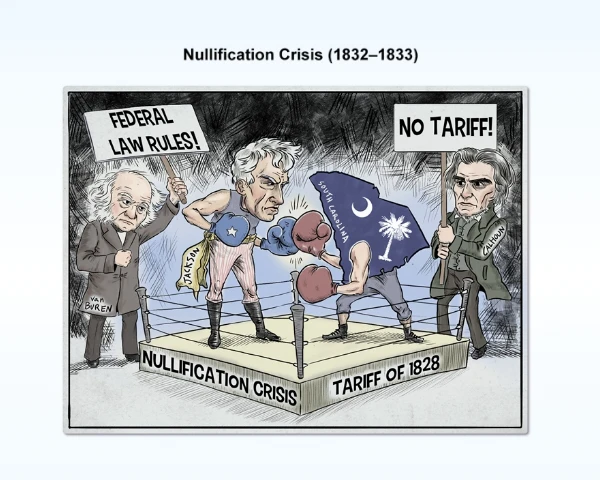
"I Know Why the Caged Bird Sings” by Maya Angelou (1969)
"I Know Why the Caged Bird Sings" is a groundbreaking memoir by Maya Angelou that explores themes of racism, trauma, and identity.21 Its significance lies in its raw honesty and the way it broke down barriers and provided a voice for marginalized communities, inspiring a generation of writers to tell their own stories.
Web Site Resources for AP U.S. History Primary Sources
For more AP U.S. History primary sources to use in their classes, APUSH teachers can search through a variety of online resources. These resources can support teachers' lessons and give students a deeper understanding of historical events and the people who were involved. The Digital Public Library of America, the National Archives, the Library of Congress, and the Gilder Lehrman Institute of American History are just a few well-known resource websites.
- National Archives: The National Archives and Records Administration's website provides primary sources such as historical documents, photographs, maps, and government records related to the history of the United States.
- National Museum of the American Indian: The National Museum of the American Indian's website provides primary sources such as artifacts, artworks, photographs, documents, and media related to the history and culture of Native American peoples.
- National Museum of African American History and Culture: The National Museum of African American History and Culture's website provides primary sources such as artifacts, documents, photographs, and media related to the history and culture of African American people in the United States.
- Office of the Historian: The Office of the Historian's website provides primary sources such as historical documents, treaties, maps, photographs, and media related to the foreign relations of the United States.
- Gilder Lehrman Institute of American History: The Gilder Lehrman Institute of American History's website provides primary sources such as historical documents, maps, photographs, and media related to American history and culture.
- The Library of Congress: The Library of Congress's website provides primary sources such as historical documents, photographs, newspapers, maps, and media related to American history and culture.
- Digital Public Library of America: The Digital Public Library of America (DPLA) website is a valuable resource for primary sources related to American history. DPLA provides access to a wide range of digitized materials from libraries, archives, and museums across the United States.
American History Primary Sources and Document-Based Questions (DBQs)
Using American history primary sources is one of the best ways for AP United States History teachers to help their students get ready for document-based questions (DBQs) on the exam. By examining primary sources, students can gain a deeper understanding of historical events, perspectives, and motivations, and develop the critical thinking skills necessary to analyze and interpret these sources. Teachers can use primary sources in a variety of ways, such as by incorporating them into class discussions, giving homework assignments involving primary source analysis, and using them as the basis for DBQ questions in class or on practice exams.
Teachers can give students a set of guiding questions when using primary sources in DBQ preparation so that students can analyze the sources and recognize important themes and arguments. Teachers can also demonstrate how to analyze primary sources by highlighting important details and elaborating on how these details connect to larger historical contexts and themes.
Additionally, APUSH teachers can help their students prepare for the exam’s DBQs by having them practice answering questions with UWorld’s Learning Tools for AP Courses. UWorld offers students access to a comprehensive library of primary sources and practice questions designed to help them prepare for document-based questions on the APUSH exam.
Key Takeaways
Primary sources are a necessary part of teaching and learning AP United States History. These sources provide students with a unique opportunity to engage with historical events through firsthand accounts and objects. Photographs, artistic creations, musical compositions, literary works, and historical documents are just a few examples of the primary source materials that teachers can use to develop interesting and educational lessons.
Discover how we help teachers who want to help their students practice analyzing primary sources for the APUSH exam with UWorld's Learning Tools for AP Courses.

References
- National Archives and Records Administration. (n.d.). America's founding documents. National Archives and Records Administration. Retrieved May 4, 2023, from https://www.archives.gov/founding-docs
- Damilola, L. (2022, July 15). 10 famous speeches that shaped history. explorethearchive.com. Retrieved May 4, 2023, from https://explorethearchive.com/famous-speeches
- Using newspapers in historical research. NC State University Libraries. (n.d.). Retrieved May 4, 2023, from https://www.lib.ncsu.edu/guides/history/newspapers
- National Archives and Records Administration. (n.d.). Brown v. Board of Education (1954). National Archives and Records Administration. Retrieved May 4, 2023, from https://www.archives.gov/milestone-documents/brown-v-board-of-education?_ga=2.116005126.1839546679.1683218847-2116274447.1683218847
- On this day, the Seneca Falls Convention begins. National Constitution Center – constitutioncenter.org. (n.d.). https://constitutioncenter.org/blog/on-this-day-the-seneca-falls-convention-begins#:~:text=Heralded%20as%20the%20first%20women’s,for%20women’s%20equality%20and%20suffrage.
- National Archives and Records Administration. (n.d.). Martin Luther King, Jr.. National Archives and Records Administration. https://www.archives.gov/nyc/exhibit/mlk
- National Archives and Records Administration. (n.d.-b). “tear down this wall.” National Archives and Records Administration. https://www.archives.gov/publications/prologue/2007/summer/berlin.html
- “letter from Birmingham Jail.” The Martin Luther King, Jr., Research and Education Institute. (2019, May 29). https://kinginstitute.stanford.edu/encyclopedia/letter-birmingham-jail
- Norwood, B. A. R. (n.d.). Biography: Nellie Bly. National Women’s History Museum. https://www.womenshistory.org/education-resources/biographies/nellie-bly-0
- Encyclopedia of the Great Plains. Encyclopedia of the Great Plains | WOUNDED KNEE MASSACRE. (n.d.). http://plainshumanities.unl.edu/encyclopedia/doc/egp.war.056
- Undercover reporting. "The Jungle: A Story of Chicago" - Upton Sinclair - Appeal to Reason · Undercover Reporting. (n.d.). Retrieved May 5, 2023, from https://undercover.hosting.nyu.edu/s/undercover-reporting/item-set/112
- Bernstein, C., Buchen, P. W. (Philip W., Buzhardt, J. F. (Joseph F., Ehrlichman, John., Ford, G. R., Goldwater, B. M. (Barry M., Haldeman, H. R. (Harry R. ), Harlow, B. N., Jaworski, Leon., Korff, B., Nixon, R. M. (Richard M., Rhodes, J. J. (John J., Richardson, E. L., Scott, H., St. Clair, J. D., Woodward, B., & Company., W. P. (n.d.). Bob Woodward and Carl Bernstein: An inventory of their watergate papers at the Harry Ransom Center. norman.hrc.utexas.edu. https://norman.hrc.utexas.edu/fasearch/findingAid.cfm?eadid=00365
- Moma learning. MoMA. (n.d.). https://www.moma.org/learn/moma_learning/dorothea-lange-migrant-mother-nipomo-california-1936/
- Joe Rosenthal and the flag-raising on Iwo Jima. The Pulitzer Prizes. (n.d.). https://www.pulitzer.org/article/joe-rosenthal-and-flag-raising-iwo-jima
- #OnThisDay: Bloody Sunday. National Museum of African American History and Culture. (2019, August 2). https://nmaahc.si.edu/explore/stories/onthisday-bloody-sunday#:~:text=Breadcrumb&text=Today%20marks%20the%20anniversary%20of,sprayed%20them%20with%20tear%20gas.
- Star Spangled Banner. The Library of Congress. (n.d.). https://www.loc.gov/item/ihas.200000017/
- Encyclopædia Britannica, inc. (n.d.). Adventures of Huckleberry Finn. Encyclopædia Britannica. https://www.britannica.com/topic/Adventures-of-Huckleberry-Finn-novel-by-Twain
- Encyclopædia Britannica, inc. (n.d.-b). The Great Gatsby. Encyclopædia Britannica. https://www.britannica.com/topic/The-Great-Gatsby
- Encyclopædia Britannica, inc. (n.d.-c). The old man and the sea. Encyclopædia Britannica. https://www.britannica.com/topic/The-Old-Man-and-the-Sea-novel-by-Hemingway
- Magazine, S. (2021, February 4). The powerful, complicated legacy of Betty Friedan’s “The feminine mystique.” Smithsonian.com. https://www.smithsonianmag.com/smithsonian-institution/powerful-complicated-legacy-betty-friedans-feminine-mystique-180976931/
- Encyclopædia Britannica, inc. (n.d.-b). I know why the caged bird sings . Encyclopædia Britannica. https://www.britannica.com/topic/I-Know-Why-the-Caged-Bird-Sings
